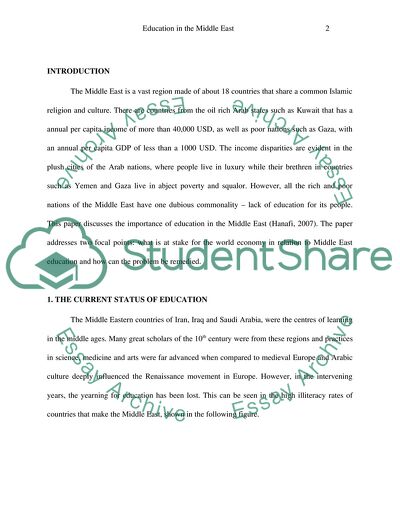
- Home
- Free Samples
- Premium Essays
- Editing Services
- Extra Tools
- Essay Writing Help
- About Us
- Studentshare
- Subjects
- Miscellaneous
- Education in the Middle East
Education in the Middle East - Essay Example

- Subject: Miscellaneous
- Type: Essay
- Level: Ph.D.
- Pages: 4 (1000 words)
- Downloads: 0
- Author: swaniawskijeram
Extract of sample "Education in the Middle East"
This paper discusses the importance of education in the Middle East (Hanafi, 2007). The paper addresses two focal points: what is at stake for the world economy in relation to Middle East education and how can the problem be remedied. The Middle Eastern countries of Iran, Iraq and Saudi Arabia, were the centres of learning in the middle ages. Many great scholars of the 10th century were from these regions and practices in science, medicine and arts were far advanced when compared to medieval Europe and Arabic culture deeply influenced the Renaissance movement in Europe.
However, in the intervening years, the yearning for education has been lost. This can be seen in the high illiteracy rates of countries that make the Middle East, shown in the following figure. For 2003, some countries and states such as Bahrain, Saudi Arabia and other have relatively lower illiteracy rates for males of 11.5% and 12.9% while for females it is 16.4% and 30.7%. Countries such as Morocco, have a higher male illiteracy rate of 34.3% while for females, the rate is 60.4%. Overall, the mean illiteracy rates for males is 15.
3% while that for females it is 30%. Illiteracy is defined as not being able to read or write even simple alphabets. When 30% of the female population is illiterate, this has a profound impact on children as studies have shown that it is the mother that has a strong influence on the child in its formative years. With lower literacy levels, the quality of education that the literate adult from Middle East shows is also reduced. Please refer to the following figure that shows the performance of students from Middle East in some internationally accepted competitive exams.
As seen in the above figure, the approximate average test score for students from middle east was 399 with the highest being from Lebanon with a score of 433. The international average is 480 while scores in the
...Download file to see next pages Read MoreCHECK THESE SAMPLES OF Education in the Middle East
Education in the Middle East in the Last 20 Years
Educational Systems of the US and Middle Eastern Countries
Empowering Women in Developing Countries
Has or Can the West be a Chance for Islam
New Independent School in the Middle East
Education of Women and Girls
The Iraq War: Strategy, Tactics, and Military Lessons
Empowering Women in Developing Countries

- TERMS & CONDITIONS
- PRIVACY POLICY
- COOKIES POLICY